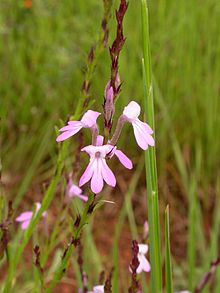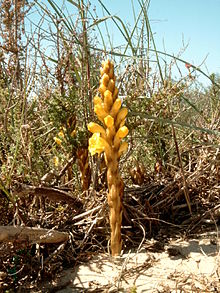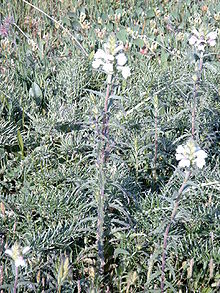- Orobanchaceae
-
Broomrape family 
Striga bilabiata Scientific classification Kingdom: Plantae (unranked): Angiosperms (unranked): Eudicots (unranked): Asterids Order: Lamiales Family: Orobanchaceae Orobanchaceae, the broomrape family, is a family of flowering plants of the order Lamiales, with about 90 genera and more than 2000 species. Many of these genera were formerly included in the family Scrophulariaceae sensu lato. Together they are a monophyletic group, forming a distinct family.
This is a cosmopolitan family, found mainly in temperate Eurasia, North America, South America, parts of Australia, New Zealand and tropical Africa.
The Orobanchaceae are annual herbs or perennial herbs or shrubs, and all (except Lindenbergia and Rehmannia) are parasitic on the roots of other plants – either holoparasitic or hemiparasitic (fully or partly parasitic). The holoparasitic species lack chlorophyll and therefore cannot perform photosynthesis. They may be yellowish, brownish, purplish, or white. Their alternate leaves have been reduced to somewhat fleshy, sessile scales. The hemiparasitic species (transferred from Scrophulariaceae) are capable of photosynthesis, and may be either facultative or obligate parasites.
Parasitic plants are attached to their host by means of haustoria, which transfer nutrients from the host to the parasite. Only the hemiparasitic species possess an additional extensive root system. In most holoparasitic species there is a swollen mass of short, bulky roots or one big swollen haustorial organ, which may be simple or composite.
The hermaphroditic flowers are bilaterally symmetrical and grow either in racemes or spikes or singly at the apex of the slender stem. The tubular calyx is formed by 2-5 united sepals. There are five united, bilabiate petals forming the corolla. The upper lip is two-lobed, the lower lip is three-lobed. There are two long and two short stamens on slender filaments, inserted below the middle, or at the base of the corolla tube, alternating with the lobes of the tube. A fifth stamen is either sterile or lacking completely. The anthers dehisce via longitudinal slits. The pistil is one-celled. The ovary is superior. The flowers are pollinated by insects or birds (e.g. hummingbirds, as in Castilleja).
The fruit is a dehiscent, non-fleshy, 1-locular capsule with many very minute endospermic seeds. These are dispersed by the wind over long distances, which increases their chance of find a new host.
This family has tremendous economic importance because of the damage to crops caused by some species in the genera Orobanche and Striga.
New genus and species
A species that had not been seen since 1985 was rediscovered in the Sierra Madre del Sur in Mexico. It is an orange-brown, fleshy-stemmed parasitic plant, with a pine cone-shaped dense cluster of flowers and juicy celery-like stalks. According to George Yatskievych, the St. Louis botanist who made the recent find, the plant's formal Latin name will mean "little hermit of Mexico." He expects it will be both a new species and a new genus because "it is so unusual and distinct that it cannot be included in any of the existing genera in the plant family Orobanchaceae". It is a parasite of Hedyosmum mexicanum.[1][2][3][4]
Genera
- Aeginetia (holoparasitic)
- Agalinis gerardia (hemiparasitic)
- Alectra (hemiparasitic)
- Ancistrostylis (hemiparasitic)
- Asepalum (hemiparasitic)
- Aureolaria (hemiparasitic)
- Bartsia (hemiparasitic)
- Bellardia (hemiparasitic)
- Boschniakia : Groundcone (holoparasitic)
- Brandisia (hemiparasitic)
- Buchnera (hemiparasitic)
- Bungea (hemiparasitic)
- Buttonia (hemiparasitic)
- Castilleja : Indian Paintbrush (hemiparasitic)
- Cellulanus parvus : Little Hermit of Mexico (holoparasitic)
- Centranthera (hemiparasitic)
- Christisonia (holoparasitic)
- Cistanche (holoparasitic)
- Clevelandia (hemiparasitic)
- Conopholis : Cancer-root (holoparasitic)
- Cordylanthus : Bird's-beak (hemiparasitic)
- Cycnium (hemiparasitic)
- Cymbaria (hemiparasitic)
- Dasistoma (hemiparasitic)
- Epifagus : Beechdrops (holoparasitic)
- Escobedia (hemiparasitic)
- Esterhazya (hemiparasitic)
- Euphrasia (hemiparasitic)
- Gerardiina (hemiparasitic)
- Ghikaea (hemiparasitic)
- Gleadovia (holoparasitic)
- Graderia (hemiparasitic)
- Harveya (holoparasitic)
- Hedbergia (hemiparasitic)
- Hyobanche (holoparasitic)
- Lamourouxia (hemiparasitic)
- Lathraea Toothwort (holoparasitic)
- Leptorhabdos (hemiparasitic)
- Leucosalpa (hemiparasitic)
- Lindenbergia (non-parasitic)
- Macranthera (hemiparasitic)
- Magdalenaea (hemiparasitic)
- Mannagettaea (holoparasitic)
- Melampyrum (hemiparasitic)
- Melasma (hemiparasitic)
- Micrargeria (hemiparasitic)
- Micrargeriella (hemiparasitic)
- Monochasma (hemiparasitic)
- Nesogenes (hemiparasitic)
- Nothobartsia (hemiparasitic)
- Nothochilus (hemiparasitic)
- Odontites (hemiparasitic)
- Omphalotrix (hemiparasitic)
- Ophiocephalus (hemiparasitic)
- Orobanche : Broomrape (holoparasitic)
- Orthocarpus (hemiparasitic)
- Parastriga (hemiparasitic)
- Parentucellia (hemiparasitic)
- Pedicularis (hemiparasitic)
- Petitmenginia (hemiparasitic)
- Phacellanthus (holoparasitic)
- Phelypaea (holoparasitic)
- Phtheirospermum (hemiparasitic)
- Physocalyx (hemiparasitic)
- Platypholis (holoparasitic)
- Pseudobartsia (hemiparasitic)
- Pseudomelasma (hemiparasitic)
- Pseudosopubia (hemiparasitic)
- Pseudostriga (hemiparasitic)
- Pterygiella (hemiparasitic)
- Radamaea (hemiparasitic)
- Rehmannia (non-parasitic)
- Rhamphicarpa (hemiparasitic)
- Rhaphispermum (hemiparasitic)
- Rhinanthus (hemiparasitic)
- Rhynchocorys (hemiparasitic)
- Schwalbea (hemiparasitic)
- Seymeria (hemiparasitic)
- Sieversandreas (hemiparasitic)
- Silviella (hemiparasitic)
- Siphonostegia (hemiparasitic)
- Sopubia (hemiparasitic)
- Spirostegia (hemiparasitic)
- Striga (hemiparasitic)
- Tetraspidium (hemiparasitic)
- Thunbergianthus (hemiparasitic)
- Tienmuia (holoparasitic)
- Tozzia (hemiparasitic)
- Triaenophora (non-parasitic)
- Triphysaria (hemiparasitic)
- Vellosiella (hemiparasitic)
- Xizangia (hemiparasitic)
- Xylocalyx (hemiparasitic)
References
- ^ mobot.org, ParasiticPlantRediscovery
- ^ blogs.nature.com, Parasitic hermit plant found in Mexico - May 01, 2008
- ^ ap.google.com, Scientist rediscovers rare plant unseen since 1985
- ^ Yatskievych, G., and J. L. Contreras J. 2009. A new genus of holoparasitic Orobanchaceae from Mexico. Novon 19: 266–276.
Categories:- Orobanchaceae
- Lamiales families
Wikimedia Foundation. 2010.


